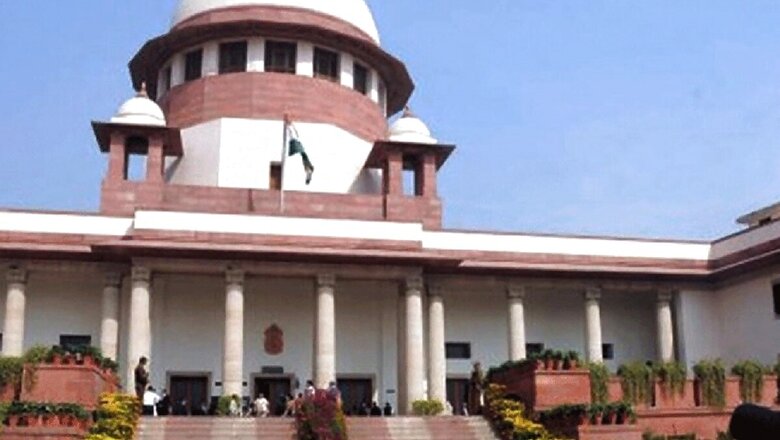
views
The Supreme Court on Thursday said some of the allegations made against judges are so shockingly false that if there had been no security of tenure, they could have been easily knocked out. The top court favoured fixed tenure of two or more years for ad-hoc judges if they are appointed in high courts to reduce the backlog of pending cases.
A special bench headed by Chief Justice S A Bobde said, “Position of judge has to be made secure. I tell you, we have seen allegations against judges which are shockingly false. Yes, some of them are shockingly false. You can easily knock out a judge if there is no security. There has to be security of tenure for ad-hoc judges.” A bench, also comprising Justices Sanjay Kishan Kaul and Surya Kant, which was hearing arguments on the modalities of appointments of ad-hoc judges, reserved verdict on a plea filed by NGO Lok Prahari seeking appointment of additional judges in the high courts under Article 224A of the Constitution in order to reduce the pendency of cases.
Article 224-A of Constitution says that the Chief Justice of a High Court for any State may at any time, with the previous consent of the President, request any person who has held the office of a Judge of that Court or of any other High Court to sit and act as a Judge of the High Court for that State. Justice Kaul said he concurs with the views of the CJI as every time a judge is appointed, frivolous complaints are made and the court cannot put the entire system of appointment of ad-hoc judges in question. Ad-hoc judges cannot be made vulnerable, the bench said, adding that too much fine-tuning may lead to losing the objective behind the appointment process.
The top court also rejected the submission of senior advocate Vikas Singh and some of other lawyers appearing in the matter that many of the former judges may not be interested in taking the job as they may be more interested in other lucrative fields like arbitration. We think this decision should be left to the former judges. We cannot decide for them. The chief justice will definitely discuss with the retired judge which is proposed to be appointed as ad-hoc judge. If the retired judge thinks that he has something better to do, then he can very well say no to the appointment, the bench said.
The CJI also brushed aside the argument that high court chief justices may not be able to hear important matters, if ad-hoc judges are appointed. “I must tell you that I was not able to hear many Constitution bench matters because there were other pressing important cases that needed to be heard at the time. However, if an ad-hoc judge is appointed then regular cases can be dealt by him and the Chief Justice can focus on important constitutional issues,” the CJI said.
On April 8, the top court had said that it is facing a natural deadline and favoured setting up a mechanism for appointment of ad-hoc judges in the high courts to reduce the backlog of cases. The top court by referring to the “natural deadline” perhaps meant the retirement of Chief Justice S A Bobde on April 23. It had asked group of senior lawyers representing different high courts to hold a virtual conference among themselves to deliberate and prepare within a week a road-map on four major points which could trigger the initiation of appointment process like-what could be percentage of pendency, how many ad-hoc judges could be appointed, how much could be the tenure of ad-hoc judges and what should the procedure.
The top court had said that it want to lay down some guidelines based on scientific mechanism by which if the pendency of cases go above a certain percentage or number, when the difference between disposal rate in comparison to rate of filing of cases goes above a certain benchmark, then the process of ad-hoc judges will get triggered. It had said that the tenure of such ad-hoc judges and the number of ad-hoc judges to be appointed will be proportional to the percentage of pendency.
The top court had said that higher the pendency in particular branches like civil or criminal or any other branch, the higher the number of ad-hoc judges will be appointed for longer tenure. It had suggested that a benchmark like red or yellow colour shall be made to denote that pendency of cases and trigger the process of appointment. The Chief Justice of the High Court will have a panel of retired judges from which they can be recommended for appointment as ad-hoc judges. This should be something scientific to prevent any arbitrariness, it had said.
The Centre had earlier said that although the government considers the issue as not adversarial, its stand on the issue is that ad-hoc appointment of judges under Article 224A should be done only after regular appointment of judges is done. The CJI had earlier said that Article 224A of the Constitution is not being used and the court may lay down guidelines for appointment of ad-hoc judges, if the pendency of it goes beyond a certain limit.
Read all the Latest News, Breaking News and Coronavirus News here. Follow us on Facebook, Twitter and Telegram.




















Comments
0 comment